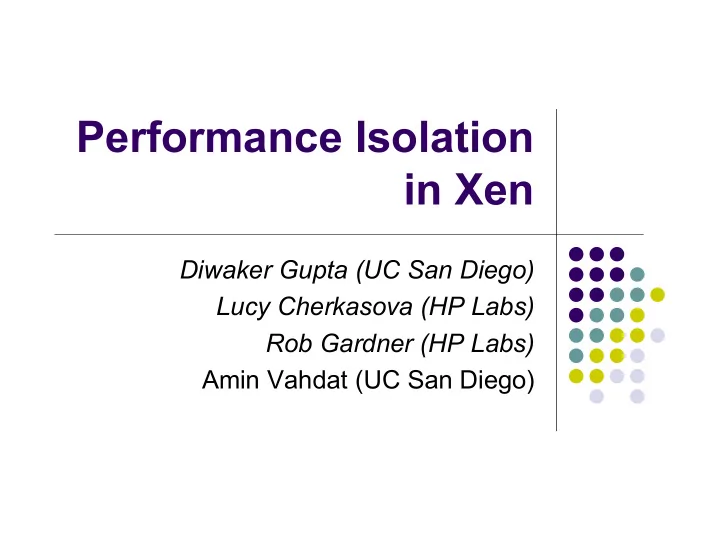

Performance Isolation in Xen Diwaker Gupta (UC San Diego) Lucy Cherkasova (HP Labs) Rob Gardner (HP Labs) Amin Vahdat (UC San Diego)
Outline Background and Motivation Controlling aggregate CPU consumption QoS in the driver domain Configuring scheduler parameters Conclusion Xen Summit, 2006
Introduction VMs provide fault isolation . Enterprise customers want performance isolation. What is performance isolation? Performance of one VM should not impact performance of another VM Related concept: resource isolation Resource isolation is necessary for performance isolation, but is it sufficient? Xen Summit, 2006
Resource Isolation Common resources: CPU, Disk, Memory, Network Spatial (disk, memory) vs. Temporal resources (CPU) Partitioning vs. Time sharing Quality of Service Availability Cost of access CPU is special: now just how much, but also when? Xen Summit, 2006
Driver Domains Execution container vs. Dom-0 VM resource principle IDD Resource consumption of netback netfront a VM may span several driver domains blkback blkfront Accurate accounting and Xen Hypervisor resource allocation Resource consumption by NIC Disk an IDD on behalf of a VM Xen Summit, 2006
General Strategy Measure Profiling tools Allocate Modifications to the scheduler Control Mechanisms to control resource usage Our work focuses on CPU and network I/O. Xen Summit, 2006
Profiling Tools XenMon Uses trace events – fairly easy to add new metrics in the framework Useful for analyzing schedulers (blocking time, waiting time etc) Metrics per execution period Other tools libxenstat and XenTop xenoprofile Xen Summit, 2006
Problem: Accounting in IDD Scenario Two enterprise customers: CPU intensive workload and interrupt driven workload (web server) Given equal shares, do they really get equal shares? Example Single CPU system, SEDF, non work-conserving VM-1: web server, 60% Dom-0: driver domain, 40% How to control aggregate CPU consumption? Xen Summit, 2006
Aggregate CPU consumption Xen Summit, 2006
Problem: Accounting in IDD Goal: allocate CPU shares accounting for aggregate CPU consumption Steps: Partition CPU consumption in IDD for different VMs Charge this debt back to the VM Heuristic for partitioning: CPU overhead is proportional to the amount of I/O Xen Summit, 2006
Packet counting in netback CPU overhead is proportional to rate of packets CPU overhead is independent of size of packets • CPU overhead is different for send and receive paths • But send:receive cost is constant Xen Summit, 2006
SEDF Debt Collector Count packets corresponding to each VM Compute weighted packet count (using the send:receive factor) Partition CPU consumed by IDD using weighted packet counts Charge debt of each VM to its CPU consumption in the scheduler Xen Summit, 2006
SEDF-DC in action Xen Summit, 2006
Problem: Accounting in IDD SEDF-DC addresses problem for SEDF in single processor case Idea can be extended to other schedulers (such as Credit) Spread debt across multiple execution periods to avoid starvation But Debt can still be very high QoS in the driver domain? Xen Summit, 2006
Controlling resource consumption in IDD Scenario SEDF, dual processor machine, non work-conserving mode Dom-1: Web server, 33% on CPU-2 (serving 10KB files) Dom-2: Web server, 33% on CPU-2 (serving 70KB files) Dom-3: File transfer, 33% on CPU-2 Dom-0: 60% on CPU-1 Goal: file transfer in VM-3 should not affect web servers in VM-1 and VM-2 Xen Summit, 2006
No QoS in IDD Xen Summit, 2006
Controlling resource consumption in IDD Problem: No way to control how much CPU each VM consumes in Dom-0 ShareGuard Periodically monitor CPU usage using XenMon IP tables in Dom-0 turn off traffic for offenders Added similar functionality to netback Repeated experiment, with VM-3 restricted to 5% CPU in Dom-0 Xen Summit, 2006
ShareGuard in action CPU in Dom-0 for Dom-3 is 4.42% over the run Xen Summit, 2006
Isolated Driver Domains Are they happening? We need accurate accounting. But how? ShareGuard only works for network I/O. What about disk? We’ve tried Memory page exchanges [USENIX 05] Weighted packet counts Instrumentation? Xen Summit, 2006
Allocating resources for IDD IDDs are critical for I/O performance Scheduling parameters have significant impact Different schedulers need different tuning Example: on a uni-processor machine, for a web server under load, is it better to give more weight to the VM or to Dom-0? Xen Summit, 2006
Work Conserving Xen Summit, 2006
Non work conserving Xen Summit, 2006
Other challenges Separating costs in presence of multiple drivers CPU partitioning for other kinds of I/O traffic Isolation of low level resources (PCI bus bandwidth, L1/L2 caches etc) Choosing and configuring the right scheduler Xen Summit, 2006
Conclusion Xen doesn’t have good performance isolation Mantra: Measure, Allocate, Control XenMon, SEDF-DC, ShareGuard are steps in this direction More work needed for SMP, non-network I/O, multiple back-ends Does the Xen community care about performance isolation? Xen Summit, 2006
Thanks! Questions? Xen Summit, 2006
The tale of 3 schedulers Three schedulers in less than two years Do end users care? Schedulers have demonstrated performance problems Questions Which scheduler to use? How to configure parameters? Should IDDs be treated specially? Xen Summit, 2006
SEDF Not very sensitive to Dom-0 weights Xen Summit, 2006
BVT Higher weight actually performs worse! Lower weight is better Xen Summit, 2006
Recommend
More recommend